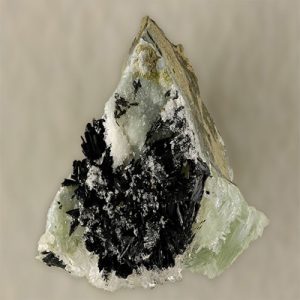Julgoldite-(Fe2+)
Julgoldite-(Fe2+) was named in 1971 by Professor Paul B. Moore in honour of Professor Julian Royce Goldsmith (1918–1999), mineralogist and geochemist, University of Chicago, Chicago, Illinois, USA, and its iron that is ferrous content. Julgoldite-(Fe2+) is a mineral that is sorosilicate a member of the Pumpellyite Group of minerals which also includes Pumpellyite-(Mg), also called Chlorastrolite. Julgoldite crystals are typically deep black colored, flat, prismatic to bladed, to 2 mm, often in fan-shaped, plumose crystal groups with near lustre that is submetallic. The formula of julgoldite is Ca2(Fe2+, Mg)(Fe3+, Al)2(Si2O7)(SiO4)(OH)2 • (H2O) (Hydrated Calcium Iron Aluminum Silicate Hydroxide) and its molecular weight is 2,199.83 gm. The specific gravity of Julgoldite is 3.58 – 3.60 (g/cm3). The crystals are frequently quite tiny but can be extremely attractive as specimens or movement that is druzy showing groups of minute deep black Julgoldite crystals on pinkish Heulandite crystals (see picture above). Probably the origin that is best of those is Nasik, Maharashtra, India. When coming to the crystal habit of this stone is Crystals flat prismatic to bladed, to 2 mm, elongated along [010] and flattened || {100}. In fun-shaped, plumose crystal groups; granular. The tenacity of this stone is Brittle.
Julgoldite-(Fe2+) distribution: At Långban, Filipstad, Värmland, Sweden. Between Tafjord and Fjøra, Sunnmøre district, Norway. Into the Ratho quarry, near Edinburgh, while the Auchinstarry quarry, Kilsyth, Scotland. In Germany, from the WolfmÄuhl quarry, Waldgrehweiler, Rhineland-Palatinate. From Hale Creek, Trinity County, Ca, plus in the Clark mine, Copper Harbor, Keweenaw County, Michigan, United States Of America. At Sawada, near Jalgaon, and Bombay, Maharashtra, Asia. In the Marlin Norite quarry, Bushveld complex, South Africa.
| Chemical Formula: | Ca2(Fe2+,Mg)(Fe3+,Al)2(Si2O7)(SiO4)(OH)2 • (H2O) |
| Hydrated Calcium Iron Aluminum Silicate Hydroxide | |
| Molecular Weight: | 2,199.83 gm |
| Composition: | Calcium | 14.57 % | Ca | 20.39 % | CaO |
| Magnesium | 0.22 % | Mg | 0.37 % | MgO | |
| Aluminum | 1.35 % | Al | 2.55 % | Al2O3 | |
| Iron | 27.16 % | Fe | 38.84 % | Fe2O3 | |
| Silicon | 15.32 % | Si | 32.78 % | SiO2 | |
| Hydrogen | 0.64 % | H | 5.73 % | H2O | |
| Oxygen | 40.73 % | O | |||
| 100.00 % | 100.65 % | = TOTAL OXIDE |
| Crystallography: | Monoclinic – Prismatic |
| Crystal Habit: | Crystals flat prismatic to bladed, to 2 mm, elongated along [010] and flattened || {100}. In fun-shaped, plumose crystal groups; granular. |
| Twinning: | Twin plane {001}, typically repeated, common. |
| Cleavage: | Perfect on {100} and {001} |
| Fracture: | Conchoidal |
| Tenacity: | Brittle |
| Moh’s Hardness: | 4.5 |
| Density: | 3.58 – 3.60 (g/cm3) |
| Luminescence: | None |
| Radioactivity: | Not Radioactive |
| Color: | Deep black, greenish black to green in small fragments; in thin section, brilliant interference colors in greens or blues | |
| Transparency: | Opaque | |
| Luster: | Nearly submetallic | |
| Refractive Index: | 1.776 – 1.836 Biaxial ( – ) | |
| Birefringence: | 0.060 | |
| Dispersion: | n/a | |
| Pleochroism: | Strong; X = pale brown; Y = pale brownish green; Z = deep emerald-green | |


